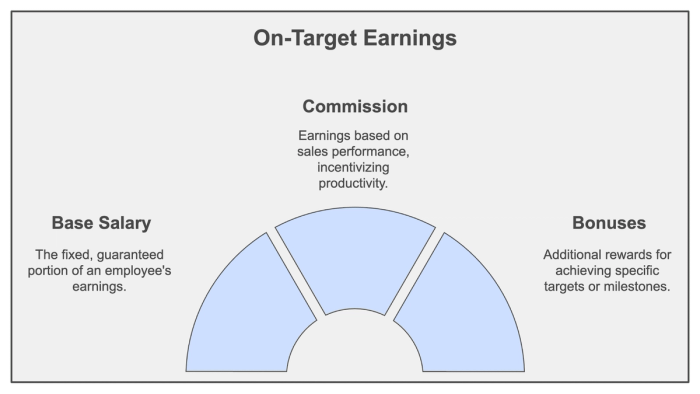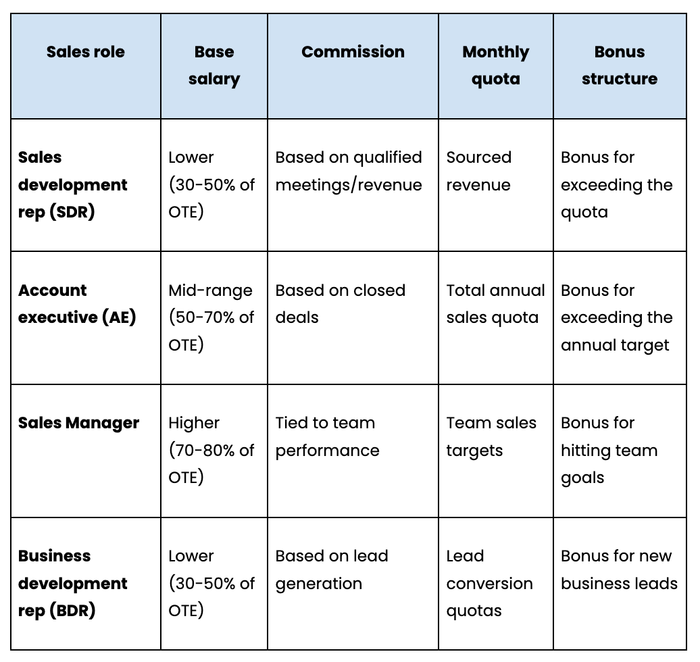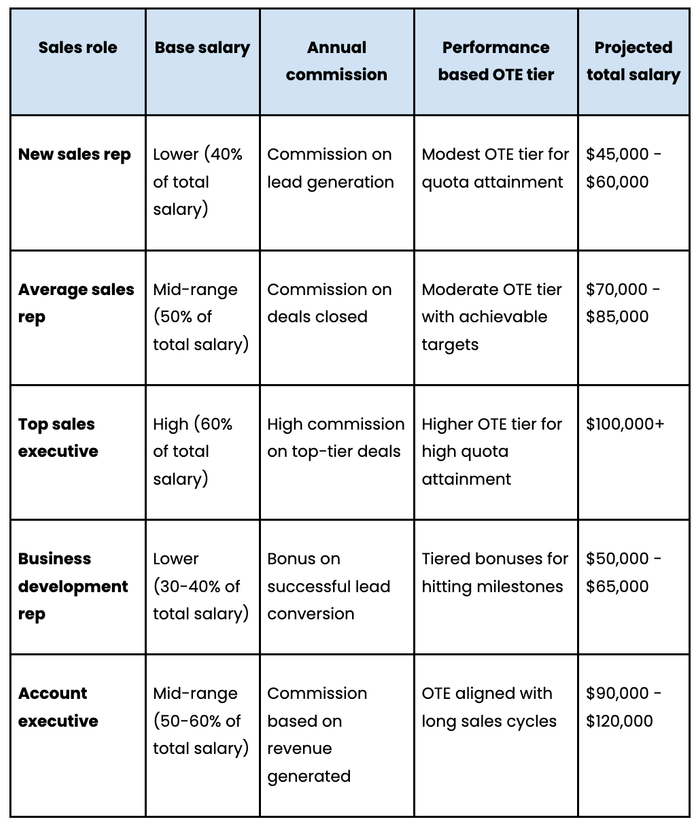Sales teams are feeling more pressure than ever, with targets climbing higher and quotas harder to hit. Managers are scrambling, doing their best to fix the situation - but it’s not always that simple.
OTE (on-target earnings) promises bigger paydays if reps meet their sales quotas. But is OTE really helping, or is it just adding to the frustration?
In this article, we’ll explore the reality behind OTE and whether it’s a lifeline or a hidden trap for your sales team.
What exactly is OTE?
OTE (on-target earnings) is a salesperson's total potential earnings if they meet all their performance targets. It’s often broken down into three main parts: base salary, commission, and sometimes bonuses. But here’s the catch — OTE is a projection, not a guarantee. It’s what sales reps could earn if they hit 100% of their targets, not what they’re promised.
The core elements of OTE
To truly grasp how OTE works, you need to know its three components:
- Base salary: The fixed part of the compensation, providing stability regardless of performance. This is what salespeople can count on each month.
- Commission: That's the performance-driven part. Sales reps earn a percentage based on their sales. For example, if you close deals worth $50,000 and your commission rate is 10%, you’d earn an extra $5,000. But this only happens if you hit the sales quotas tied to your OTE.
- Bonuses: Additional incentives paid for achieving specific goals, such as exceeding your sales quota or closing high-value deals.

To understand the true potential of OTE , you need to know how it varies depending on the sales role, compensation structure, and quota expectations.
For example, sales professionals in longer sales cycles typically have a higher base salary portion. At the same time, account executives working with faster-paced deals may see a larger percentage tied to commissions.
Fully ramped OTE represents the earning potential when a sales rep is up to speed and consistently hits targets. OTE calculations differ by industry, too, often factoring in specific goals and sales process complexities – which influence the total compensation package.
Why OTE can be a sales team’s best friend?
When structured well, the on-target commission becomes a powerful motivator for sales teams.
High performers see clear goals tied to financial rewards. Sales reps know exactly what they need to hit. OTE ties compensation directly to performance, pushing sales professionals to achieve their best without confusion.
OTE's transparency makes it easier for sales managers to forecast costs and track performance. Managers can gauge how their team is progressing toward the total annual sales quota and how expected average rep earnings align with business objectives.
With such clarity, quotas remain achievable.
Comparison table: OTE models across sales roles

However, OTE isn’t always the golden ticket it appears to be.
The dark side of OTE – when does it become a problem?
Why do some sales representatives feel like they’re chasing an impossible dream with OTE?
It often comes down to poorly designed compensation plans. When hiring managers inflate targets or set unrealistic sales quotas, the promise of hitting target earnings OTE becomes a burden rather than a motivator.
What once inspired your sales team to perform better can start feeling like an impossible hurdle, causing morale to drop and can lead to burnout. Instead of increasing employee engagement, these high, unattainable quotas leave teams feeling defeated.
A poorly structured OTE model leads to frustration because sales reps feel like they are constantly behind.
Sales development representatives who struggle to meet their sourced revenue quota or sales executives who miss their targets often become disillusioned. The dream of that shiny OTE salary fades as sales organizations focus too heavily on unattainable numbers – pushing reps further from success.
Consistently missing the mark on on-target earnings can have a ripple effect.
Not only does it weaken trust in the company’s compensation model, but it also results in a demotivated sales force. In the worst cases, sales candidates leave, new sales reps quit, and businesses face higher turnover – all because their OTE goals felt like a trap.
How to build a fair and motivating OTE structure in 2025

Step one: Review sales quotas
We already mentioned that setting unrealistic quotas is a recipe for burnout. Sales leaders should calculate OTE based on industry benchmarks and their team's past performance.
Use accurate data to set quotas that stretch your sales employees but aren’t impossible. If quotas don’t align with reality, the promise of on-track earnings quickly becomes a myth. Maintain trust by tying quotas to realistic targets.
Step two: Balance base salary with commission
Small businesses don’t need to gamble with unstable pay structures. It’s a common misconception that only high-risk pay models can attract talent. Instead, create a well-balanced pay mix that stabilizes the employee’s base salary and offers on-target commissions. This balance provides stability while ensuring your team stays motivated to hit targets.
Step three: Maintain transparency in OTE calculation
If your sales team isn’t clear on their OTE, they’ll likely lose interest and motivation.
Imagine this: a sales rep is working extremely hard – but is unsure how much of their effort translates to actual earnings. They might close a massive deal without understanding how it contributes to their overall compensation goal.
Break down the OTE in simple terms. Highlight the annual base salary, commission structure, and any bonus opportunities. For even more clarity, keep this information accessible at all times – like a written breakdown in your team’s shared drive or CRM.
This way, each team member knows exactly what they’re working toward and how to reach it.
Step four: Regularly adjust OTE based on market conditions
Market conditions can shift overnight, so you have to be agile. When competitors adjust their pay packages to attract top talent or new trends demand different sales approaches, a static OTE can feel outdated and unattractive.
For example, if demand shifts or the cost of living rises, you need to adjust OTE to ensure your team feel valued, even if they're performing well.
Regular reviews ensure your OTE compensation aligns with new market trends, economic shifts, and team productivity.
Step five: Tailor OTE for each sales role
A one-size-fits-all OTE model doesn’t work for a diverse sales team. Each role has unique responsibilities, targets, and challenges, so tailoring compensation makes it more effective and fair.

For instance:
- An account executive whose main job is closing deals should have an OTE emphasizing commission, rewarding them for each closed sale.
- A sales development representative (SDR) focused on lead generation could benefit from an OTE with a higher base salary and achievable bonuses – reflecting the longer sales cycle of their work.
- A customer success manager (CSM), responsible for client satisfaction and upsell opportunities, might have an OTE that leans more heavily on retention bonuses.
Step six: Introduce team-based incentives
When incentives focus solely on personal achievements, collaboration often falls by the wayside.
To avoid that, you can, e.g., match business development representatives (BDRs) with specific account executives (AEs) and set a joint goal – like securing a certain number of high-value deals each quarter.
With both roles sharing the reward, they’ll have a real reason to sync up on strategies, share insights, and help each other close deals. And when everyone’s invested in a shared outcome, the entire team can feel the lift – not just in revenue but in energy and camaraderie, too.
Step seven: Forecast OTE with data, not guesswork
Success doesn’t come from guesswork. You can’t predict it without data. Sales leaders must lean on performance analytics and historical data to accurately forecast OTE. If you set quotas based on gut instinct or round numbers, you risk creating unrealistic goals that only frustrate your team.
Data-driven forecasting includes past deal sizes, win rates, and average sales cycles. With these insights, you can set achievable quotas that push your team to perform.
Step eight: Use non-cash rewards to boost engagement
Want to boost morale without breaking the bank? Non-cash rewards can be just as powerful as financial incentives for increasing employee engagement.
For instance, offering an extra day off for meeting monthly quotas, covering the cost of a professional course, or recognizing top performers in a company-wide spotlight can work wonders for engagement. These rewards give employees something memorable and personally meaningful – without inflating project expenses for the company.
Step nine: Support your high performers to prevent burnout
Protecting your high performers from burnout is very important – these are the people driving most of your revenue, and their energy fuels team success. But they’re also the ones most prone to stress and exhaustion from constantly pushing to meet ambitious targets.
To keep them thriving, offer regular check-ins, advanced training, and access to mentorship that helps them navigate challenges and sharpen their skills. Providing support beyond just numbers ensures they don’t feel overwhelmed, and helps them stay motivated and focused on reaching – and surpassing – their sales goals.
Performance-based OTE – not every rep should get the same deal
A one-size-fits-all approach to sales compensation rarely meets the mark. Each sales role brings unique contributions to the table, and their on-target earnings (OTE) should reflect these differences. Tailoring OTE based on each sales rep’s role and performance helps reward top achievers while setting achievable, motivating goals for others.
See how performance-based OTE tiers can work for growth paths, bringing flexibility and fairness to your team’s compensation model:

There are three main benefits of performance-based OTE:
- Achievement-based recognition. High achievers can earn more through elevated commission rates and bonuses that reflect their impact. Top performers see the benefits of their hard work in their overall compensation, making their efforts feel truly valued.
- Team motivation. A performance-based structure keeps all team members engaged. While top sales executives push for higher targets, others – like new sales reps or mid-tier performers – are still motivated with more attainable goals.
- Realistic quota attainment. With flexible performance-based tiers, quotas match each role’s responsibilities and growth potential. A sales executive may have a higher OTE, but their quota will reflect their seniority and ability to close bigger deals. On the other hand, a business development representative may focus on lead generation – with more modest yet attainable targets.
Choosing the right pay mix
Structuring the OTE pay mix requires a careful balance between base salary and commissions. The right mix can drive your sales staff while allowing businesses to manage risk and avoid excessive commission costs. Here’s a look at common pay structures and their effects on both sales reps and the company.
50/50 pay mix: A balanced approach to on-target earnings
In this model, 50% of the rep’s compensation comes from a base salary and the other 50% from commissions.
This balance is ideal for roles where job descriptions focus on generating leads and closing deals. It will also be a good option for companies offering balanced rewards without high-risk commissions.
The base salary provides financial stability, helping reps feel secure, while the commission drives them to waste no time. However, it may not fully reward high performers, as the commission component can feel limited.
70/30 pay mix: higher risk, higher reward for sales reps
In a 70/30 pay mix, 70% of a sales rep’s compensation is commission-based, with only 30% coming from a base salary.
This structure works best in high-velocity, short-cycle industries like retail or SaaS, where higher sales are the norm. It perfectly suits new or ambitious sales reps willing to take on greater risk for the potential of higher rewards.
The large commission component fuels aggressive selling but also means more risk for reps if they fall short of targets. Payout amounts may fluctuate based on sales performance or sales cycle length.
30/70 pay mix: a security-first strategy
The 30/70 pay mix means 30% of the rep’s compensation comes from commission, while 70% is a guaranteed base salary.
This setup is perfect for roles centered on maintaining client relationships and spotting upsell or cross-sell opportunities. It works well in positions that balance client service with periodic sales.
Naturally, the commission component still encourages reps to seek revenue opportunities within their accounts – but without the intensity of high-pressure sales.
OTE: a tool for success if you know how to use it
OTE can either drive your team to new heights or leave them stuck.
OTE keeps your sales team motivated and committed to realistic targets when structured right. But if it’s misaligned, it can hold back performance and morale. Oh, and sink performance faster than missed quotas.
If you want to keep the best talent in your sales positions and avoid burnout, ensure your OTE drives success, not frustration.
Want to ensure your sales strategy stays on track? Capsule CRM can help you manage your team’s performance – keeping OTE targets in line and transparent.
Take control of your team’s performance by integrating Capsule to keep motivation high in 2025!




